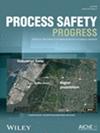Study of ethanol vapor explosion and prediction based on chemical kinetics under high temperature and pressure
IF 1
4区 工程技术
Q4 ENGINEERING, CHEMICAL
引用次数: 0
Abstract
The study of the explosion parameters of ethanol–air mixture at high pressure and temperature is essential for the safe production of ethanol. However, the explosion characteristics of ethanol vapor at various pressures and temperatures are limited. The mechanism at the flammability limits of ethanol has not been clarified, and the corresponding prediction model is also lacking. In this study, chemical kinetics and machine learning are used to study the mechanism of ethanol explosion and build predictive models, respectively. Our findings show that an increase in the initial pressure has a more pronounced influence on the explosion pressure (Pex) and pressure rise rate (dp/dt) than an increase of temperature. The variation trend of the upper flammability limit (UFL) of ethanol is related to the different effects of temperature and pressure on OH radicals. H + O2<>OH + O and HO2 + CH3<>OH + CH3O had the greatest effect on the generation of OH radicals. The quantitative relationship between the H, O, and OH radicals and UFL was constructed by machine learning, providing a new research perspective for the prediction of the UFL of an inflammable fuel under different pressures and temperatures. The results of the study will provide theoretical and practical guidance for the prevention and control of explosions in the ethanol production process.高温高压下乙醇蒸汽爆炸研究及基于化学动力学的预测
研究乙醇-空气混合物在高压和高温下的爆炸参数对乙醇的安全生产至关重要。然而,乙醇蒸汽在不同压力和温度下的爆炸特性却很有限。乙醇易燃极限的机理尚未阐明,也缺乏相应的预测模型。本研究利用化学动力学和机器学习分别研究乙醇爆炸的机理和建立预测模型。研究结果表明,与温度升高相比,初始压力升高对爆炸压力(Pex)和压力上升速率(dp/dt)的影响更为明显。乙醇可燃上限(UFL)的变化趋势与温度和压力对羟自由基的不同影响有关。H + O2<>OH + O 和 HO2 + CH3<>OH + CH3O 对 OH 自由基的生成影响最大。通过机器学习构建了H、O和OH自由基与UFL之间的定量关系,为预测不同压力和温度下易燃燃料的UFL提供了新的研究视角。研究结果将为预防和控制乙醇生产过程中的爆炸提供理论和实践指导。
本文章由计算机程序翻译,如有差异,请以英文原文为准。
求助全文
约1分钟内获得全文
求助全文
来源期刊

Process Safety Progress
工程技术-工程:化工
CiteScore
2.20
自引率
10.00%
发文量
99
审稿时长
6-12 weeks
期刊介绍:
Process Safety Progress covers process safety for engineering professionals. It addresses such topics as incident investigations/case histories, hazardous chemicals management, hazardous leaks prevention, risk assessment, process hazards evaluation, industrial hygiene, fire and explosion analysis, preventive maintenance, vapor cloud dispersion, and regulatory compliance, training, education, and other areas in process safety and loss prevention, including emerging concerns like plant and/or process security. Papers from the annual Loss Prevention Symposium and other AIChE safety conferences are automatically considered for publication, but unsolicited papers, particularly those addressing process safety issues in emerging technologies and industries are encouraged and evaluated equally.
 求助内容:
求助内容: 应助结果提醒方式:
应助结果提醒方式:


